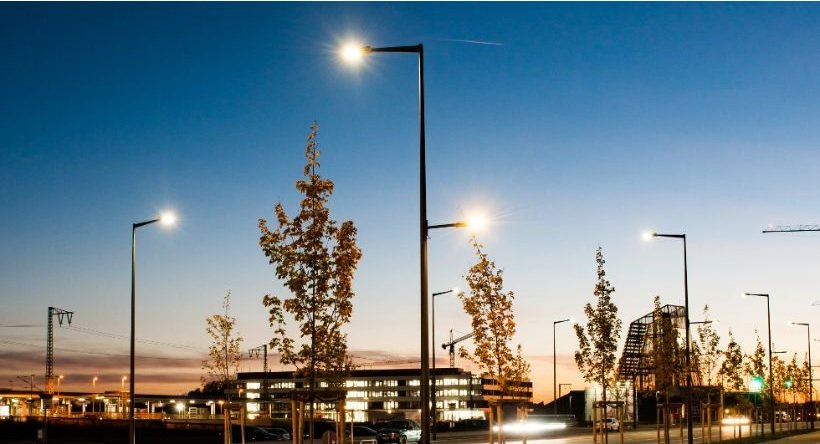
This week and last week, Innovation Origins is looking at the growing influence of wireless communication within today’s society and in particular at data transmission via electromagnetic with ever-higher frequencies, such as 5G.
The Eindhoven-based Signify (formerly Philips Lighting) is planning to have a group of around fifty ‘average consumers’ test LiFi in their own homes within a year. Signify has the technology ready for this form of data communication via light sources. However, the device that transfers data received and sent to a phone, tablet, television, laptop, or computer is still too big for the consumer market. That’s what Ed Huibers and Ivo Rutten, the go-to-market leaders at Signify, say about LiFi.
The device, a dongle with a USB connector that connects a mobile device to the LiFi network, is now slightly smaller than e.g. an Apple magic mouse.
3,5 Watt
“That’s not such a problem for a computer,” says Rutten, who will be guiding the product to the consumer market over the coming years. “But at the moment it uses 3.5 Watts. That’s less than an LED lamp though still too much to connect your mobile phone or tablet to.”
That means the battery will be drained in a couple of hours. Huibers foresees that the definitive dongle for LiFi that consumers will one day be able to buy in shops or from a telecom provider will be about the same size as a USB stick. “We don’t see any major obstacles in the way when it comes to making that happen.”
12 kilo
The first device that Huibers used to demonstrate how LiFi sent data to and from a computer weighed 12 kilos, he tells us. So, now that has already been reduced to about one hundred grams.
Rutten thinks that the initial launch on the consumer market will be via a large telecom provider such as Ziggo, KPN, or any of the other providers. “We’re not network specialists. Such organizations have a call center with employees behind their helpdesks. I can imagine that at some point such a company will add LiFi to its standard package for TV, internet, and telephony. Instead of WiFi, they will then offer LiFi, if you opt for that as a customer.”
Another problem is also that the device providing the LiFi signal, which must be placed inside a lamp, is too big. Currently, it’s about 10 by 5 centimeters in size and roughly three centimeters thick. At any rate, due to its size, it will not easily fit under a lampshade without you being able to notice it. If it were so small that it fits into the base of the LED light bulb, that would be ideal, Rutten believes.
A few tenners
It might take another three or four years before that happens, Rutten thinks. He is reluctant to introduce the LiFi devices onto the market too prematurely and is averse to criticism on social media. For instance, in case the LiFi devices are considered to be too big for network communication. They have to be produced on a large scale so that they cost no more than a few tenners. At the moment, they would still be too expensive for a lot of people.
“If you have LiFi in your home, you should hang the lamps in all the places where you want excellent internet. Like in the kitchen, the study, the living room. Then you need several lamps,” Rutten adds. The lamps may last twenty years because they are LED lamps that can burn for up to 25,000 hours. But they still need to be affordable. Otherwise, it’s not a good product, as far as Rutten is concerned.
Always hassles with WiFi
The introduction of LiFi onto the consumer market could herald a revolution in how the internet is used. The major advantage of LiFi is that it can transmit data much faster than WiFi. The spectrum used for data transmissi9n is much larger and at the same time highly localized.
With WiFi, there is often strong competition among the many users of the same frequency spectrum who all tend to get in each other’s way. “The problem with WiFi is that you have – or think you have – connectivity anytime and anywhere,” says Rutten. “But because everyone can access it, sometimes in some places it’s not available to anybody in the end.”
No latency issues with LiFi
With LiFi you know for sure that there is connectivity at a specific location. Yet that’s only at that particular spot where the lamp is mounted. Although you do have a guaranteed reach then too. Plus, there is no delay (otherwise known as latency issues) in the network either. Your messages are always sent directly. This is not the case with WiFi. When it’s busy on the network, your message might be sent milliseconds, and sometimes even seconds later. “This is especially unacceptable if you want to play a computer game, for instance,” Rutten points out. Because then you might lose just because your opponent isn’t affected by any latency issues somewhere else.
A further advantage is the manageability of the network. This is only accessible at the spot where the lamp actually lights up. There is no reach beyond the space around the lamp. Intercepting the signal from outside is also impossible. Hassles with WiFi – lsuch as last year when Russian spies tried to intercept data traffic via WiFi from the Organisation for the Prohibition of Chemical Weapons (OPCW) in The Hague (here in the Netherlands) by using receivers in the boot of a car – you won’t have any trouble like that with LiFi, Huibers adds. Since that incident, Signify has been in talks with the Ministry of Defense about the installation of LiFi.
Demand skyrocketing in the business sector
In the business sector, demand for LiFi is skyrocketing, as was shown in a presentation by Huibers last month. General industry, the hotel industry, aviation, and train manufacturers and office operators are all interested in acquiring LiFi. This year Signify expects more than double the number of LiFi installations compared to last year. Signify is using the existing cable network for the installation of LiFi in the business sector.
It is still too early for data transmission via the existing electricity network for consumer households. It is interesting for this group, and the existing network is still being used for WiFi. But we are still working on improving the technology for receiving and sending data via LiFi over the electricity network, Rutten goes on to say. This is another reason why it will be a while before LiFi can be installed inside the home.
Read more IO aricles on LiFi via this link.
Read IO articles about 5G via this link.







